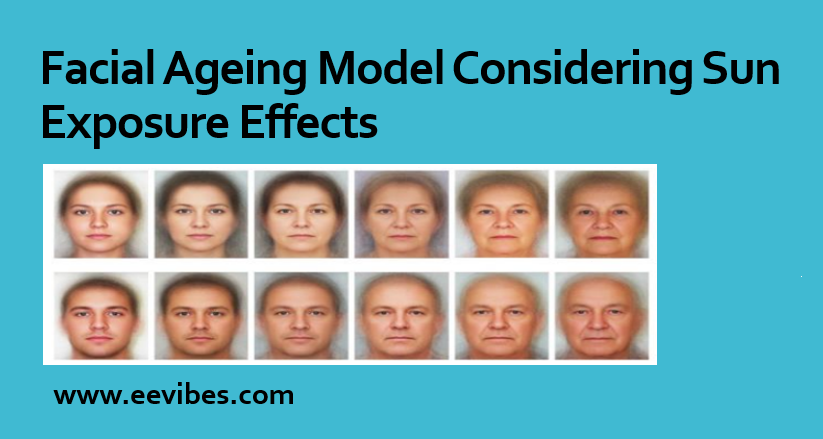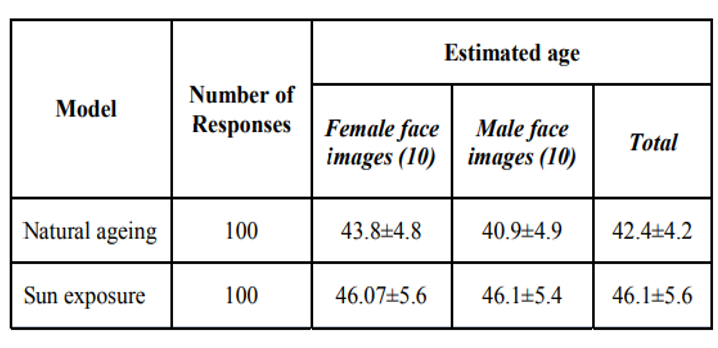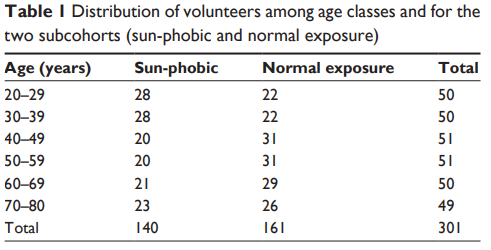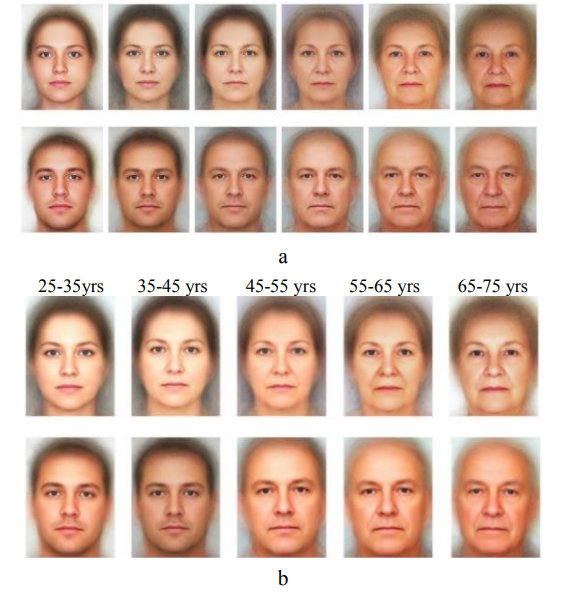
Introduction
In this topic, Facial Ageing Model Considering Sun Exposure Effects have been explained. Aging stands as one of life’s undeniable certainties. Despite being a definite and impending process, it is far from consistent or linear, with each individual following a unique aging trajectory. The pace of facial aging for each person is intricately linked to a multitude of internal and external factors that can potentially modify the aging process.
Among these factors, sun exposure looms as the most influential environmental element, prompting a call to reduce prolonged exposure to sunlight. Diverging from the multitude of studies centered on the natural aging process, this study introduces a behavioral facial aging model, driven by the purpose of underscoring the adverse effects of sun exposure on an individual’s perceived age. Initially, a predictive aging model is established, utilizing the natural aging process as a foundation.
This model is further augmented by a coefficient derived through statistical analysis, revealing the contrast in apparent age between those who eschew sun exposure and those who actively seek it. These two components synergize to form the basis of the ultimate model, conclusively illustrating that individuals who actively pursue sun exposure tend to exhibit an appearance that surpasses their chronological age.
While it’s undeniable that individuals of the same age often share some facial similarities, it’s important to recognize that each person’s aging process is unique and influenced by a range of intrinsic and extrinsic factors. While intrinsic traits are relatively resistant to change, altering one’s lifestyle can significantly mitigate the impact of extrinsic factors.
Demonstrating the consequences of high-risk behaviors on an individual’s facial appearance over time is considered one of the most effective ways to create awareness about them. The primary objective of Behavioral Face Aging Models is to offer a perspective on how lifestyle choices can impact one’s facial aging, helping individuals make informed decisions about their future choices.
Many models in the existing literature predominantly focus on predicting how a face will naturally age over time. For instance, some researchers, like Burson and Schneider, have observed variations between young and old faces and used this knowledge to alter a young face accordingly.
Other researchers, like Rowland and Perrett, have modified the age of input images by applying warp fields and color adjustments. Pitanguy Et Al have described a pattern of facial parameter changes during the aging process based on numerical measurements from samples.
However, previous models in the literature have often overlooked the influence of lifestyle choices on facial aging. Recent work has started to address this gap, as evidenced by a predictive model illustrating the impact of methamphetamine addiction on an individual’s facial appearance and age.
In the present study, we introduce a predictive model of facial aging that takes into account a crucial behavioral factor – cumulative sun exposure. This model is specifically designed to predict the effects of sun exposure on facial aging.
Facial aging is an intricate process influenced by a combination of intrinsic and extrinsic factors. Intrinsic factors, also known as chronological or genetic factors, are inherent to an individual and play a significant role in the natural aging process.
One of the key contributors is genetics, which determines the rate at which the skin loses collagen and elastin, proteins vital for maintaining skin firmness and elasticity. As individuals age, there is a natural decline in hormone production, particularly estrogen and testosterone, leading to reduced skin thickness and hydration.
The genetic blueprint also influences the structure of the face, determining aspects such as bone structure and fat distribution. Over time, changes in facial fat distribution contribute to sagging and loss of volume, affecting the overall contour and appearance.
Intrinsic factors also encompass metabolic processes, with a decrease in cell turnover and regeneration affecting the skin’s ability to repair and renew itself. These inherent factors, though inevitable, serve as the baseline upon which extrinsic factors exert their influence.
Extrinsic factors, on the other hand, are external elements that accelerate the aging process and are often within an individual’s control. Sun exposure is a primary extrinsic factor, and its effects are cumulatively significant over time. Ultraviolet (UV) radiation from the sun leads to collagen degradation, elastin damage, and the formation of free radicals, ultimately resulting in wrinkles, fine lines, and uneven skin tone.
Sun exposure is also a major contributor to the breakdown of the skin’s supportive structure, leading to sagging and loss of elasticity. Environmental pollutants, such as air pollution and tobacco smoke, constitute another extrinsic factor that accelerates facial aging.
These pollutants generate free radicals that promote oxidative stress, causing cellular damage and premature aging. Smoking, in particular, is associated with accelerated collagen breakdown and reduced blood flow, contributing to a more aged appearance. Lifestyle choices, including diet and alcohol consumption, also impact skin health. A diet rich in antioxidants, vitamins, and minerals supports skin resilience, while excessive alcohol intake and poor nutrition can exacerbate the aging process.
LITERATURE SURVEY
Facial aging is a natural and gradual process that involves various changes in the skin, underlying tissues, and muscles of the face over time. It typically begins in the mid-20s and becomes more noticeable as individuals get older. Common signs of facial aging include the development of fine lines and wrinkles, loss of skin elasticity, and the formation of age spots and uneven pigmentation.
The underlying fat and muscle structure may also change, leading to volume loss, sagging, and the appearance of hollowed areas. Additionally, collagen and elastin production decrease, resulting in thinner and less resilient skin. External factors such as sun exposure, smoking, and lifestyle choices can accelerate these aging effects.
While facial aging is a natural part of life, many people choose to address these changes through various cosmetic procedures, skincare regimens, and lifestyle modifications to maintain a youthful appearance and boost self-confidence.
Sun Exposure refers to the exposure of one’s skin and body to the sun’s ultraviolet (UV) radiation. This natural phenomenon is a primary source of vitamin D, vital for bone health, immune function, and overall well-being.
However, it comes with both benefits and risks. Moderate sun exposure can enhance mood by promoting the production of serotonin, a neurotransmitter linked to happiness and mental health. It also helps regulate circadian rhythms and improve sleep patterns. On the flip side, excessive sun exposure, especially without proper protection like sunscreen and protective clothing, can lead to sunburn, skin damage, premature aging, and an increased risk of skin cancer.
Over time, UV radiation can harm the skin’s DNA and cause mutations that contribute to skin cancer development. Therefore, it’s essential to balance the advantages of sun exposure with responsible sun safety practices to protect your skin and health.
Aging manifestations can be categorized into four primary groups: wrinkles/texture, loss of skin tissue firmness (ptosis), vascular irregularities, and variations in pigmentation. Over the course of one’s life, changes in skin appearance and structure occur not only due to natural aging processes and inherent factors but also as a result of various external influences like the force of gravity, exposure to the sun and ultraviolet rays, and heightened pollution levels.
Lifestyle choices, such as diet, tobacco use, illness, and stress, also exert noticeable and significant effects on skin aging. These external factors contribute to the gradual deterioration of the skin, manifesting at different rates. The primary objective of this study was to quantitatively assess the impact of sun exposure on facial aging by examining the emergence of distinct new signs or the amplification of traditional aging indicators.
Facial aging due to sun exposure, often referred to as photoaging, is a process where the sun’s ultraviolet (UV) radiation accelerates the visible signs of aging on the face. Prolonged and unprotected sun exposure can lead to a range of adverse effects on the skin, including the formation of fine lines, wrinkles, and deep creases.
UV radiation breaks down collagen and elastin fibers in the skin, resulting in a loss of elasticity and firmness. Additionally, it can cause the appearance of age spots, uneven pigmentation, and a leathery texture. The cumulative damage from the sun’s rays over time can exaggerate the overall aging process, making individuals appear older than their actual age.
Furthermore, UV exposure can exacerbate existing skin conditions and worsen the effects of other aging factors, such as genetics and lifestyle choices like smoking. It’s important to note that the harmful effects of sun exposure are preventable through the consistent use of sunscreen, protective clothing, and hats. Reducing sun exposure during peak UV hours and seeking shade can also mitigate these aging effects. By taking these precautions, individuals can help maintain a more youthful and healthier appearance while reducing their risk of skin cancer.
Facial aging aggravated by sun exposure primarily involves a complex mechanism driven by the sun’s ultraviolet (UV) radiation. UV rays penetrate the skin and initiate a cascade of damaging processes. One of the key mechanisms is the degradation of collagen and elastin, essential proteins responsible for maintaining skin structure and elasticity.
UV radiation activates enzymes called matrix metalloproteinases (MMPs), which break down collagen and elastin fibers. As these fibers weaken and decrease in quantity, the skin loses its ability to bounce back, leading to the formation of fine lines and wrinkles, particularly in areas frequently exposed to the sun, such as the face. Moreover, UV exposure can trigger the overproduction of melanin, the pigment responsible for skin color, leading to the development of age spots and uneven pigmentation.
This hyperpigmentation is a response to protect the skin from further UV damage but results in visible discoloration. Additionally, UV radiation can cause the release of free radicals, highly reactive molecules that damage DNA and accelerate cellular aging.
This damage accumulates over time, increasing the risk of skin cancer, including basal cell carcinoma, squamous cell carcinoma, and melanoma. Sun exposure also weakens the skin’s natural barrier function, making it more susceptible to environmental pollutants and irritants. As a result, the skin may become dry, sensitive, and prone to a variety of skin conditions, further contributing to the appearance of aging.
The Incidence of Skin Cancer attributed to sun exposure remains a significant public health concern, warranting attention and preventative measures. Numerous studies and epidemiological data consistently link prolonged and unprotected exposure to ultraviolet (UV) radiation from the sun to an increased risk of developing various forms of skin cancer.
Basal cell carcinoma and squamous cell carcinoma, while generally less aggressive than melanoma, account for a substantial portion of skin cancer cases, and their prevalence is notably associated with sun-induced damage.
Moreover, the deadliest form of skin cancer, melanoma, exhibits a clear connection to sun exposure, particularly in cases of intense sunburn during childhood and adolescence. This official report emphasizes the critical importance of public education and awareness campaigns, as well as the promotion of sun safety practices, including the use of broad-spectrum sunscreen, protective clothing, and seeking shade during peak UV hours, in mitigating the incidence and burden of skin cancer caused by sun exposure.
Collaboration between healthcare authorities, educational institutions, and the broader community is essential in addressing this preventable public health issue.
Ensuring the integrity of the skin is essential to maintain its role as a physical barrier against external substances, microorganisms, and dehydration, while also fulfilling social and aesthetic purposes.
In recent years, innovative technologies rooted in physical principles have been introduced alongside the development of new active ingredients for various formulations. One such technology is Cold Atmospheric Plasma (CAP), which has demonstrated promising results in dermatology and is currently under investigation for its potential applications in skin treatments and care. CAP biomedical studies encompass diverse expertise, spanning from physics and chemistry to biology and biochemistry, rendering the subject complex.
This review provides a comprehensive exploration of the interactions between CAP and the skin. The initial section covers essential aspects of skin structure and physiology, highlighting its vital functions, and introduces the fundamental principles of cold plasma and its physicochemical properties. Subsequent sections analyze each CAP parameter in detail, shedding light on the known effects and potential impacts on the skin.
This overview aims to convey the potential of cold atmospheric plasma technology in the realm of skin biology, with implications for future developments in dermo-cosmetic treatments, including applications in aging prevention.
METHODOLOGY
While facial aging varies from person to person, individuals within the same age group exhibit certain common facial aging patterns. To investigate these shared characteristics within an age cluster, an average face is computed. Initially, feature extraction is applied to all the images within a specific age group. Subsequently, the average of each feature point is determined, and all faces are adjusted to align with these average coordinates. Finally, the average of all the facial images in the cluster is computed, with a high-pass filter applied to enhance texture details in the face images before averaging.
For each facial image, represented by denotes the pixel value at position, represents the template face for a given age cluster, defined by the template color, which is the average pixel value at the same pixel position across all facial images in that age cluster. The aging progression across different decades is evidently distinct.
To create these templates, a dataset of 700 adult facial images from various age decades was compiled through web image searches. The images were segregated by gender and categorized into six different age decades. To account for variations in face tilt and image resolution, normalization was applied to ensure all images had a uniform resolution of 500×500 pixels.
Given a calculated ∆ value of 3 for sun exposure as a behavioral factor, the existing templates were found to be unsuitable for use in models. Consequently, Coalesced Templates were generated by merging adjacent templates.
The model is utilized on a database comprising 20 adult facial images, all of which exhibit a frontal orientation and minimal facial expressions. Initially, the natural aging model is employed with this dataset. As per the model’s design, it takes a standard adult facial image as input and generates an approximation of how it would appear within the 41-50 age range. A selection of these outcomes is depicted.
To assess the results, subjective performance evaluation is employed. We solicited assessments from 100 individuals who were presented with the results featuring faces in the 41-50 age group and asked to estimate the age of the facial image.
The calculated average and standard deviation for these evaluations are displayed in the first row of Table. The table reveals that the outcomes align with the desired age range, according to the respondents. Hence, it can be concluded that the proposed model demonstrates a notably accurate performance.

Subsequently, the Sun Exposure Facial Ageing Model is applied to the same database. In this model, an ordinary adult facial image is used as input, and the model predicts how it would appear in the 41-50 age range considering cumulative sun exposure.

RESEARCH ON CHINESE WOMEN
The research was carried out in Guangzhou (Canton, 22°N, 113°E), the capital of the Guangdong region, known for its high solar irradiation level (10 hours/day). The average annual Ultraviolet A (UV A) doses are 1,050 kJ ⋅ m–2 ⋅ day–1, and average annual Ultraviolet B (UV B) doses are 28 kJ⋅ m–2 ⋅ day–1. Apart from UV radiation (280–400 nm), which constitutes 7% of solar energy on the skin, previous literature has specified that the visible light spectrum (400–760 nm) and infrared (IR) radiation (760–3,000 nm) contribute 39% and 54%, respectively, to solar energy affecting the skin. In particular, Infrared A (IRA) radiation (760–1,440 nm), comprising 30% of IR radiation, is noteworthy for its deep penetration into the skin, especially the dermis, and its impact on higher phototypes.
A total of 301 healthy Chinese women aged 20– 80 years participated in the study, recruited through a dermatologist’s clinical assessment to ensure the absence of any specific skin disorder other than dry or greasy skin.
All subjects had lived in Guangzhou for more than 10 years, and for most, both parents were Guangzhouese. This recruitment strategy aimed to minimize biases related to lifestyle and pollution and focus on the impact of solar exposure. Smoking habits were not considered during volunteer selection, as previous literature suggests that skin damage due to sun exposure is more significant than that induced by cigarette smoking.
All participants completed a questionnaire focusing on sun exposure behavior throughout their lives, including the duration of exposure each day and week, UV protection habits, types of transportation used, outdoor activities, and work settings. This allowed the creation of two subcohorts: sun-phobic (S-P) subjects (140 women) actively avoiding sun exposure through measures like hats, umbrellas, masks, and UV protecting cosmetic products, and normal (sun) exposure (NE) subjects (161 women) who did not particularly pay attention to sun exposure in their daily activities. Both groups were balanced in age and phototypes (II to IV) and further subdivided into 10-year age classes for statistical analysis, as shown in Table 1.
Table 2 details the lifetime solar exposure, indicating a weekly duration of solar exposure for NE subjects three times higher than S-P subjects throughout their lifespan.


